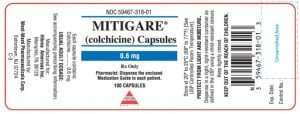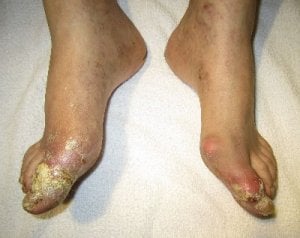Though uric acid concentration in your blood is only one of the factors affecting gout, it is the most important gout test result.
Uric Acid Concentration Introduction
Uric acid concentration is helpful in gout diagnosis, but vital in gout treatment and control. It is the easiest way to assess how successful your treatment is. This is true whether you have a uric acid lowering program managed with your doctor, or if you are trying to control gout using natural remedies.
Your uric acid number is important, and you should know it. You also need to know the letters and symbols that follow your number. Different scales exist, and you must understand which scale is used for your uric acid blood test results. If you forget the scales, it’s the same as getting confused between pounds and kilos – nothing makes sense.
Uric Acid Calculator
In the uric acid levels chart, I show you uric acid levels on different scales so you can easily convert one to the other. This is the best way for many gout sufferers to understand their uric acid blood test results. Other people prefer a more direct uric acid conversion method, and so I have developed the Uric Acid Calculator.
Measuring Scale Conversion
Please note that this measurement scale converter relies on the molecular weight of uric acid, and it only applies to uric acid.
Convert mg/dL to mmol/L
If you have a uric acid blood test result in mg/dL, enter the number in the first box, and then press your Tab key, or click the Convert button.
Convert mmol/L to mg/dL
If you have a uric acid blood test result in mmol/L, enter the number in the second box, and then press your Tab key, or click the Convert button.
Convert μmol/L to mg/dL
If you have a uric acid blood test result in μmol/L, you can use the mmol/L conversion, but divide your result by 1000 first. For example, if your result is 456μmol/L enter .456 in the mmol/L box, and then press your Tab key, or click the Convert button.
Convert mg/dL to μmol/L
If you want mg/dL to μmol/L uric acid conversion, enter your mg/dL value in the first box, then multiply your result by 1000. For example, if your value is 8.6mg/dL enter that in the first box, and then press your Tab key, or click the Convert button. The mmol/L box will show .51, so your result is 510μmol/L.
Other Measurement Conversion Methods
If you prefer lists to calculators, please see the Uric Acid Levels Chart.
If you prefer your own calculator, 0.0594847691033 is the molecular weight conversion factor for uric acid. To keep things simple, I use 0.06, so the conversions are:
| From↓ \ To→ | mg/dl | mmol/L | μmol/L |
| 5mg/dL | 5 | multiply by 0.06 = 0.30 | multiply by 60 = 300 |
| 0.30mmol/L | divide by 0.06 = 5 | 0.30 | multiply by 1000 = 300 |
| 300μmol/L | divide by 60 = 5 | divide by 1000 = 0.30 | 300 |
Uric Acid Concentration: Next Steps
Note that, though the calculator gives very accurate results, your uric acid concentration varies through the day, and from day to day. You really have a range of values, so if you get a result of 6.9 mg/dL, it is best to regard it as 6.4 – 7.4 mg/dL. That is why we say that 5 is safe – it gives a good safety margin for fluctuations, and is unlikely to be above 6, where risk of gout gets increasingly higher.
If you need any help understanding your uric acid concentration, please ask in the gout forum.
Leave Uric Acid Concentration to browse more Uric Acid Guidelines.
Uric Acid Concentration Related Topics
Please remember: to find more related pages that are relevant to you, use the search box near the top of every page.
Common Terms: convert, Uric Acid Levels
Other posts that include these terms:
- Gout Medications To Avoid Gout By Lower Uric Acid
- Uric Acid Levels: Safe or Dangerous?
- How Your Uric Acid Level Changes
- Uric Acid Calculator from Safe to Dangerous
- Krystexxa (pegloticase)
- Uricase for Fast Uric Acid Control
- Uric Acid: Step-by-Step Understanding
Please give your feedback
Did this page help you? If yes, please consider a small donation. Your donations help keep GoutPal's gout support services free for everyone.
If not, please tell me how I can improve it to help you more.
- YouTube
- The gout forums.









